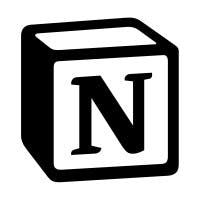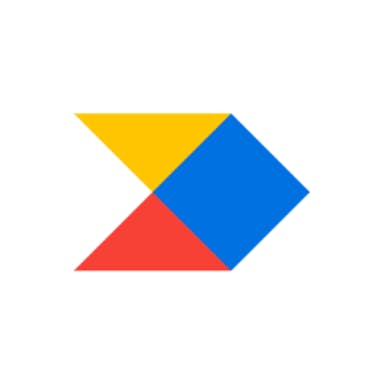Thesis
In the history of publishing, technological innovations tend to create the biggest inflection points, especially when it comes to publishing costs. Johannes Gutenberg's invention of the movable-type printing press in 1436 lowered the cost of printing books significantly compared to copying manuscripts by hand. Texts could reach mass audiences for the first time, leading to what would later become the mass media of the modern era.
But business model innovations have also been critical in driving publishing costs lower. In the 1800s, for example, Benjamin Day invented the business model that has underpinned the news industry for the subsequent 200+ years: advertising-based revenue. He did this by founding the first-ever penny newspaper, the New York Sun. It quickly grew to become the most-read newspaper in America because, instead of charging the industry average of six cents, the Sun charged a penny and made up lost sales via ad-driven revenue. This model was one of the first to leverage media network effects and formed the foundation of some of the largest newspapers in the world.
The advent of the internet drove publishing costs effectively to zero, allowing writers to self-publish content and promote it to millions of people. Despite this large technologically-driven shift, however, the economic model underpinning publishing remained the same as it had been before: advertising. Tech giants like Meta and Google later captured much of this advertising revenue, leading to financial difficulties for many news outlets. As of November 2023, a research study revealed that Google and Meta potentially owe $12 billion to publishers and that small publishers that rely on traffic from Meta have lost between 20% - 30% of their audiences.
In response, newspapers and other publications shifted towards digital subscriptions. The Wall Street Journal was the only newspaper that required a digital subscription in 1997. As of April 2024, 75% of US newspapers, magazines, and journals are behind online paywalls. Meanwhile, although large publications were able to successfully navigate the shift, independent writers and bloggers still struggled financially.
That's where Substack comes in. Substack is a subscription-based newsletter publishing platform that allows independent writers to build and monetize their audience directly. By focusing on subscriptions instead of advertising as its primary business model, Substack enables writers to establish a more sustainable income stream while maintaining creative control over their content. The platform aims to offer a user-friendly interface that simplifies the process of starting and managing an email newsletter, enabling readers to discover, follow, and support the writers they enjoy.
To enhance the reader experience, Substack has developed a mobile app that provides a native reading environment. The app also incorporates social features such as recommendations and comments, fostering a growing network of engaged writers and readers. By prioritizing direct relationships between creators and their audience, Substack allows writers to cultivate a dedicated following without relying on advertisers or third-party publishers for distribution.
Founding Story
Substack was founded in 2017 by Chris Best (CEO), Jairaj Sethi (CTO), and Hamish McKenzie (Chief Writing Officer).
The team first met while working together at Kik, a free messenger app that Best had co-founded. Both Best and Sethi graduated from the University of Waterloo. At Kik, Sethi served as the Head of Platform for nearly six years. McKenzie was a former journalist who had written for various newspapers and magazines. He met Best and Sethi while doing communications work for Kik, where McKenzie had worked as an Editorial Advisor.
In October 2017, the trio began working on a prototype of Substack. They started the company based on the belief that there had to be a better way for writers to make money from their work. In their view, the media business was already in bad shape at the time. In the 1990s, Craigslist launched and disrupted the newspapers' classifieds business, while Google and Facebook continued to take over the ads business. This led to newspapers shutting down and journalists losing jobs. Simultaneously, social media products optimized for "engagement" and were creating an attention economy that rewarded extreme reactions and outrage.
The Substack founders believed that for great writing to flourish on the internet, the media world needed an alternative to online advertising. They saw direct payments between readers and writers as a better path forward. The founders planned on building the platform with a subscription-based model, where the reader, not an advertiser, becomes the primary customer. The founders also believed that a writer with a subscription publication can only succeed if the reader feels well-served. If the writer can achieve that and a small audience, Substack can help support a lucrative business for the writer.
So, after launching in 2017, the Substack founders first built an enterprise email delivery tool and web publishing software. The team then used Mckenzie’s connection to Bill Bishop, the writer of a newsletter called Sinocism, and convinced him to launch the first publication on Substack. On October 18, 2017, Bishop sent an email to his 30K subscribers informing them that his daily newsletter was moving behind a paywall. Sinocism had brought in six figures of revenue by the end of that day.
After Sinocism launched, Substack began attracting a diverse group of writers including The Shatner Chatner by Daniel Ortberg, who was co-founder of The Toast, and an anonymously authored newsletter called Petition that discussed the bankruptcy industry. In early 2018, Substack opened up registration to the public, enabling anyone globally to create and monetize a newsletter publication.
The company participated in Y Combinator’s Winter 2018 batch. By October 2018, one year after launching, newsletters published on the Substack platform reached a total of 150K paid active readers. The company’s customer base grew to 25K paid subscribers, up from 11K just three months prior in July 2018.
Product
Substack is an open marketplace for writers to create and monetize newsletters, and for readers to discover and subscribe to newsletters from their favorite writers. Alongside newsletters, Substack has recently been growing the podcast component of its product, enabling anyone to produce a paid, subscription-based podcast on the platform. Substack aims to enable creators to focus on the content they produce and use Substack for other aspects of running an independent creator business, from subscription management to payments.
Newsletters
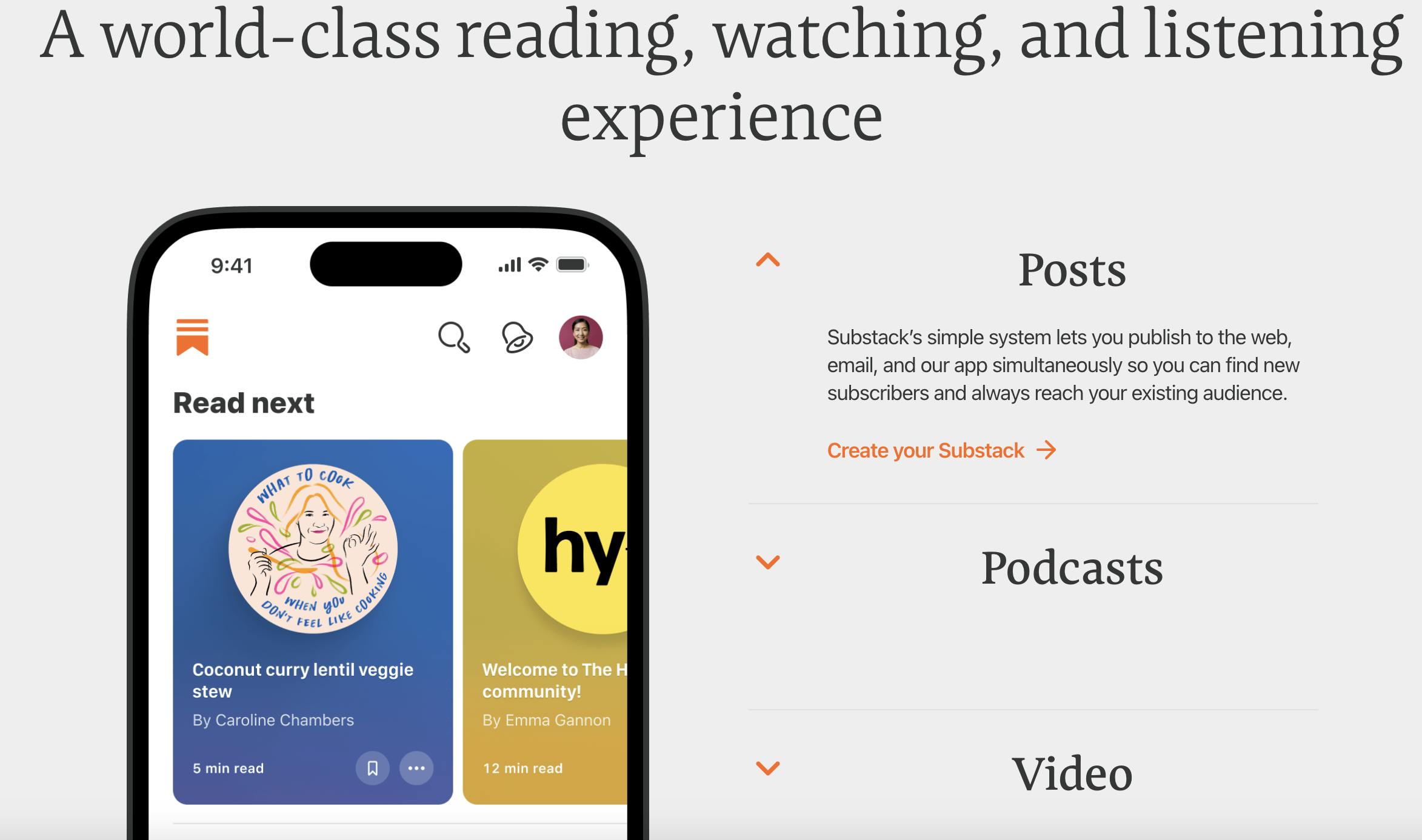
Source: Substack
Substack provides a minimalistic interface for writers to create content. Writers can embed links, audio, and video into their newsletters to create an engaging, multi-content viewing experience. Once the content has been produced, writers can distribute it via email to their subscribers and on social media through a linked post. Each post can have a subscribe button, and writers can keep some or all of their posts behind a paywall.
In January 2023, Substack introduced "private Substacks," a feature that allows writers to create exclusive, invitation-only newsletters. Readers must request to subscribe to these private newsletters, and writers can approve or decline these requests, which appear as emails in the host's inbox. Once approved, the reader is automatically subscribed to the private newsletter, making it an ideal tool for building niche communities and testing the waters for new publications.
Writers can also create a customizable publication page, which displays all their work in a unique style while utilizing Substack’s backend functionality for writing, distributing, and payments. Substack offers a standard UI for publication pages, which is ideal for new publications, and supports the creation of custom pages that build upon Substack’s existing UI framework.
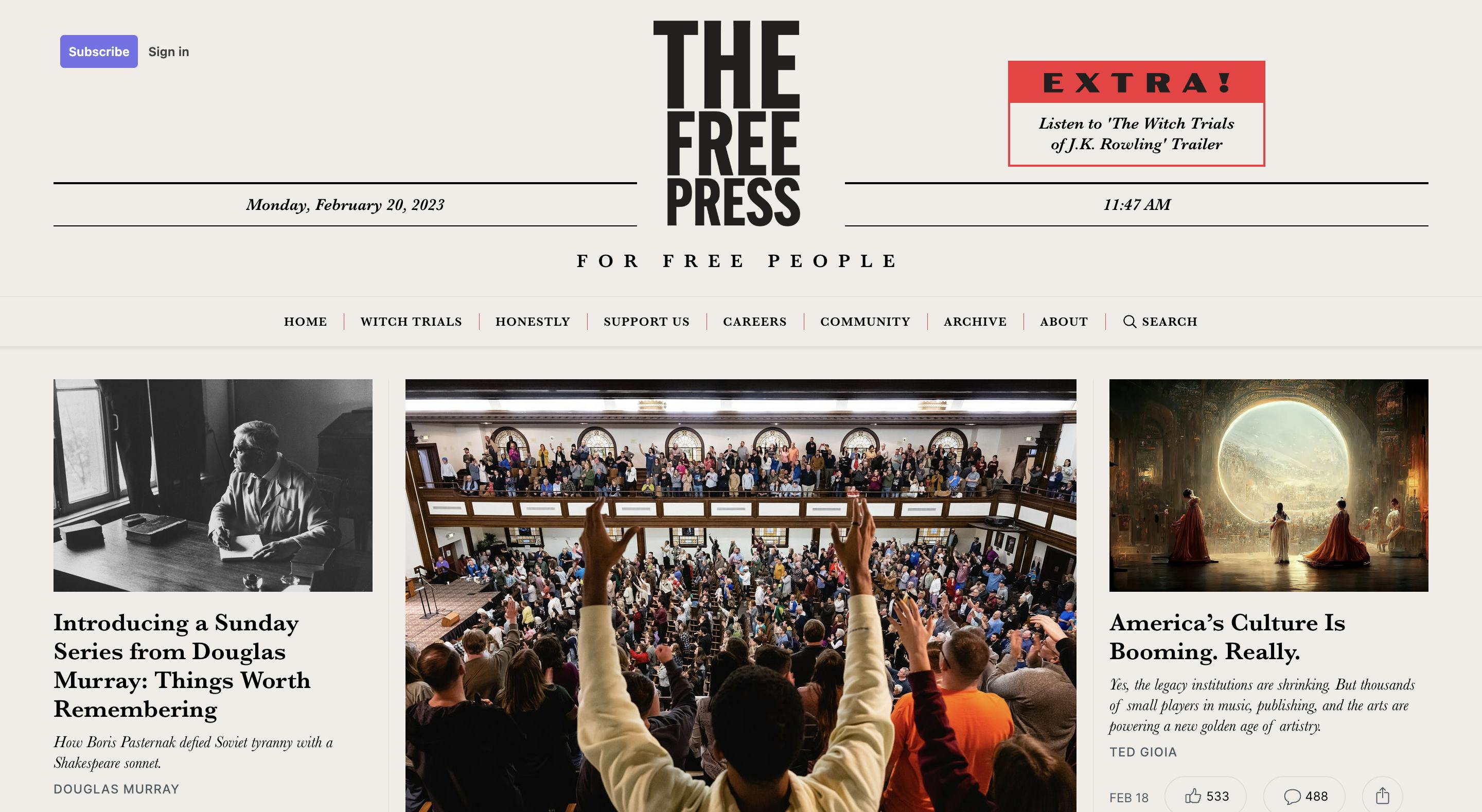
Source: The Free Press
Podcasts
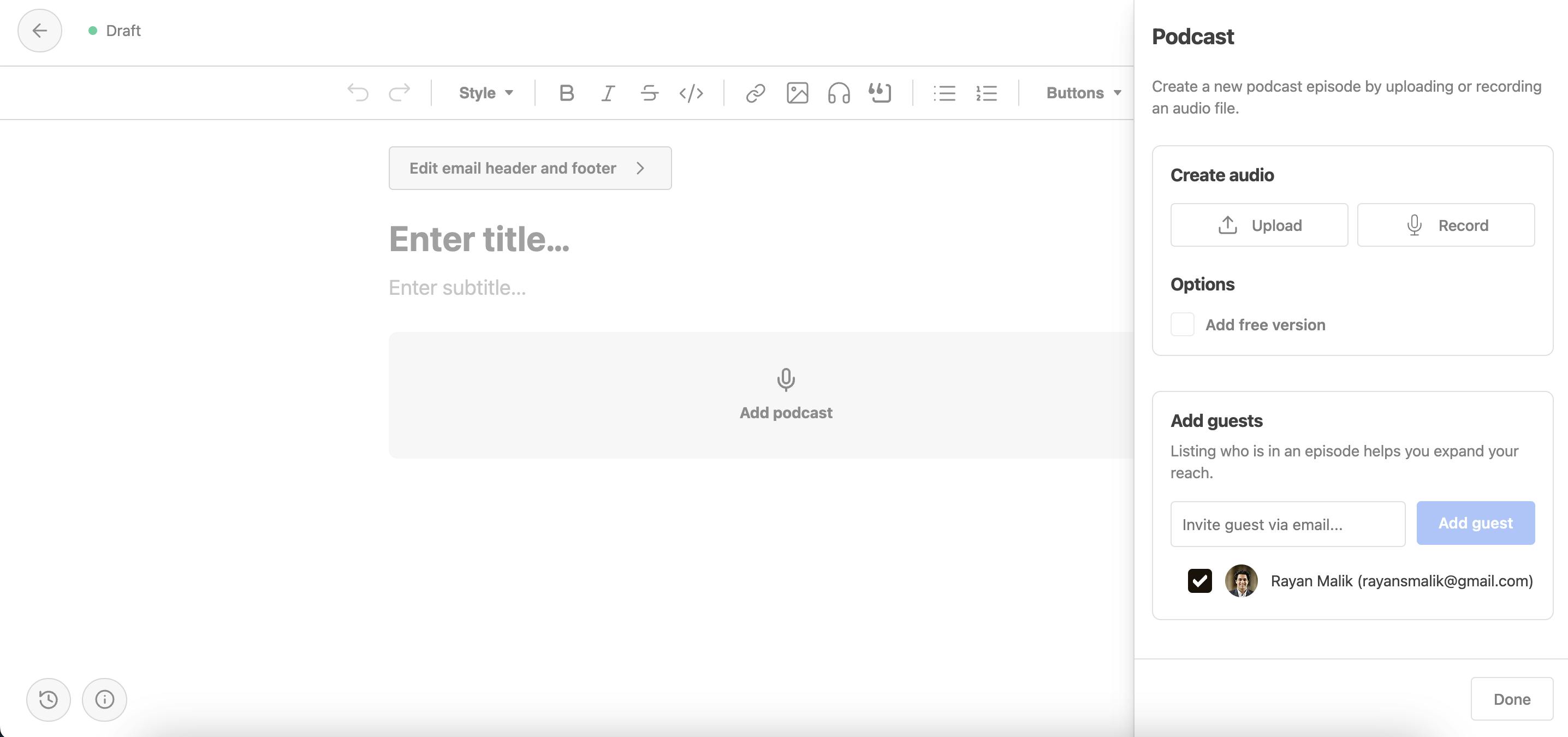
Source: Substack
Substack’s podcast feature is a basic audio editor that allows users to record audio content in Substack. This recorded content can be embedded within a newsletter or published as a solo podcast episode. The podcast feature also lets users upload pre-recorded audio content. Most publications are divided into a newsletter section and a podcast section, allowing subscribers to shift between the two depending on their intent. The podcast feature allows writers to rely less on advertising and monetize the podcasts through subscriptions.
Analytics
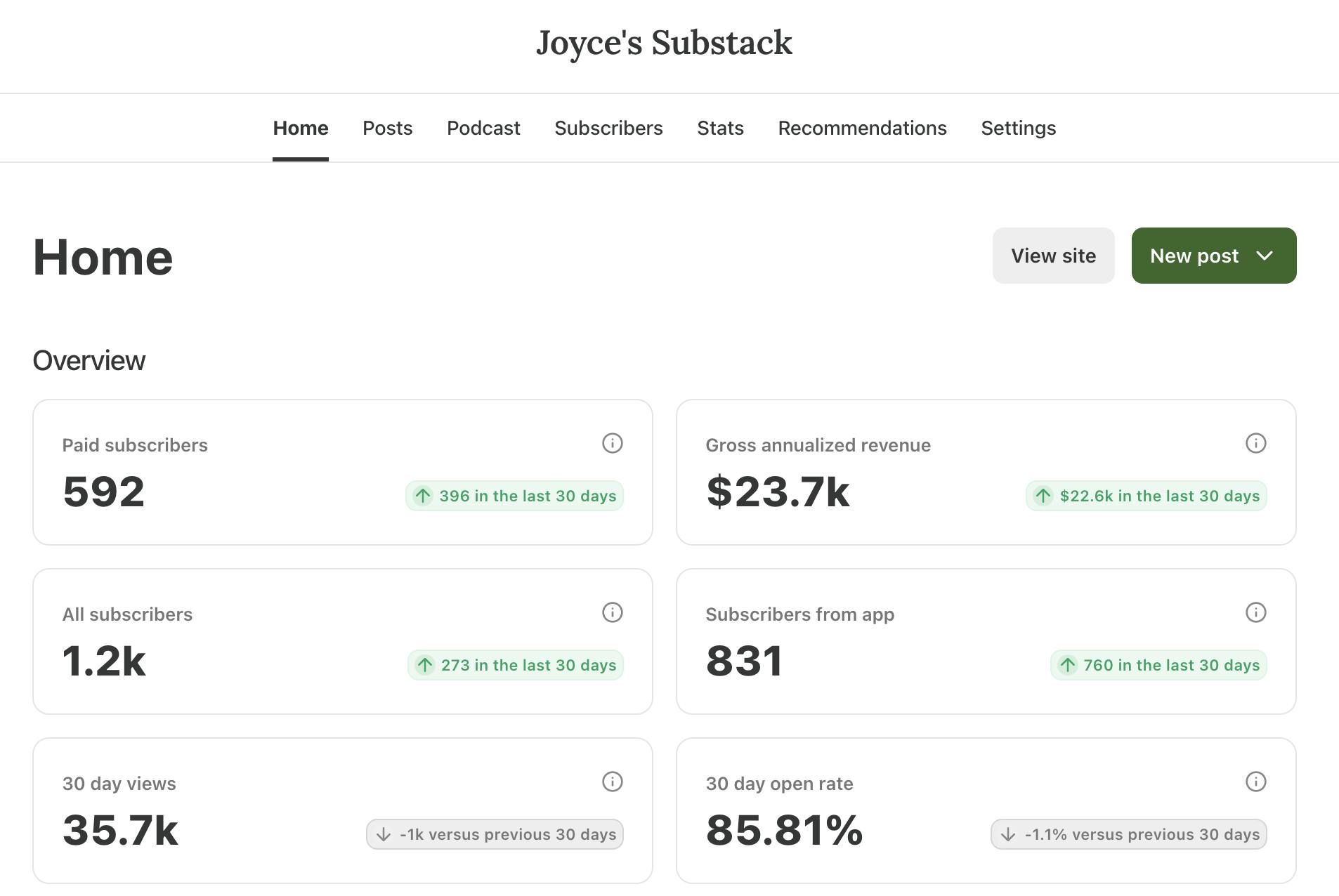
Source: Substack
Substack provides writers with in-depth analytics. Writers can view a list of subscribers, subscriber activity, revenue per subscriber, conversion rates, audience demographics, and more. This provides writers with critical information to help expand their audiences and understand their readers.
Further, writers can link their Google Analytics Pixel ID, Facebook Pixel ID, and Parse.ly Pixel ID to track paid ad performance and better understand the conversion rates and other metrics of ad campaigns on social media.
Writers can also engage with their audience through direct chats. This enables the discussion to continue beyond a post and adds a personal touch.
Notes
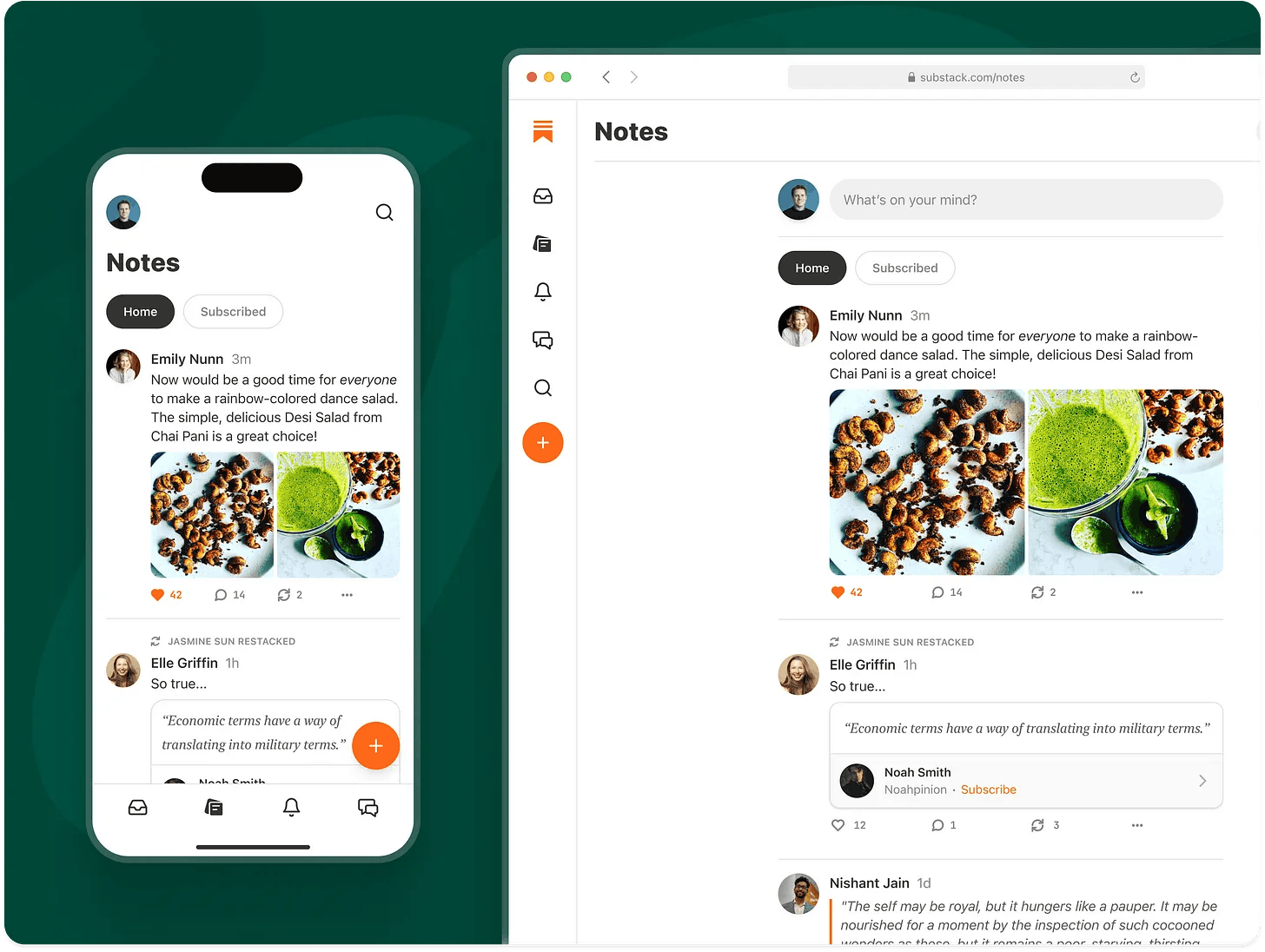
Source: Substack
In April 2023, Substack launched Notes, a feed-based feature that allows writers to post short-form content to their audience. Notes has a social media feed-like interface but does not contain ads. Users can like, comment, and “restack” or share notes. The Notes feed is located on the home page of the Substack app, where it helps readers discover new writers and stay updated on their current subscriptions. Writers also have the option to embed Notes within their newsletters.
In August 2023, Substack introduced a new feature that allows readers to follow writers without subscribing to their newsletters. When readers follow a writer, they can stay updated on what the writer is reading, liking, publishing, and subscribing to through the Notes feed and the writer's profile. This feature aims to help writers grow their audience and maximize subscriptions by leveraging Substack's network of readers, while still maintaining the importance of paid subscriptions as the primary type of relationship on the platform.
Recommendations
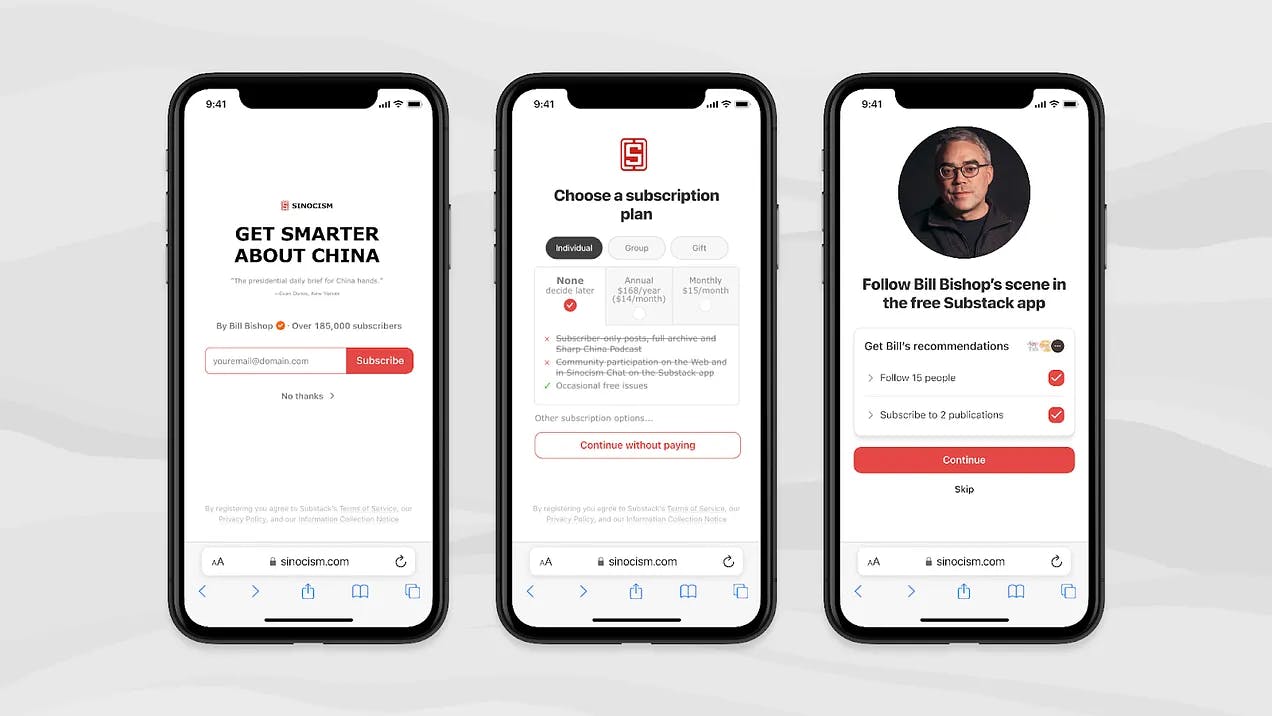
Source: Substack
Substack’s recommendations feature allows writers to promote other publications to their audience. When a reader subscribes to a writer, they are prompted to also subscribe to a curated package of other writers recommended by the original author.
As of February 2024, the recommendations feature has driven 50% of new subscriptions and 25% of new paid subscriptions on Substack. This feature encourages a "goodwill growth loop" where writers can cross-promote and recommend each other’s work, reducing sole dependence on algorithms for discovery. Substack provides writers analytics showing how many new subscribers they gain from recommendations and how many other newsletters are recommending their own publication.
Chat

Source: Substack
In February 2024, Substack released a new social feature called Chat, enabling users to have private one-on-one conversations. This feature is designed to help writers build subscriber loyalty and connect with other writers on the platform.
In March 2024, Substack expanded its interactive chat feature by introducing an integrated video tool for creators. Newsletter writers on the platform can record and upload videos directly from their phones to send to their subscribers via chat. Subscribers will receive instant notifications when a new video is available. This feature is designed for publishers who want to communicate with their audience more personally and directly through video content.
Substack also expanded its chat functionality in May 2024 by allowing writers to paywall their entire chat or specific threads, making them accessible only to paid or founding members. The company believes this feature will help maintain intimate and troll-free conversations while also serving as a paid perk for readers. Substack's data shows that active chat participants are 12% more likely to retain their subscriptions to writers’ publications.
Mobile App
In March 2022, Substack launched its mobile app for iOS and Android, providing readers with an ad-free space to read their favorite writers' content and discover new publications. As of September 2023, the app has been downloaded over 3 million times and boasts a 4.9-star rating from more than 50K reviews on the App Store. It has become a growth channel for writers, with more than 25% of recent subscriptions coming directly from the app and app users having 50% more paid subscriptions than non-app users.
The Substack app aims to offer several features to increase reader engagement and conversion. As of September 2023, app users are 15 times more likely to comment, 44 times more likely to share a post, and 25% more likely to become paid subscribers compared to non-app users. The app's ad-free reading experience, navigation, and user-friendly interface contribute to these engagement metrics. Readers can also participate in discussions, save posts for later, listen to audio versions of posts, and easily access all their subscriptions in one place.
Market
Customer
When Substack launched in October 2017, its initial users were independent writers seeking ways to monetize their content and maintain direct relationships with their subscribers. These writers covered a wide range of topics such as finance, culture, politics, technology, and business. The company focused on building tools for professional writers, as opposed to amateurs or semi-professionals, due to their clear need for an independent publishing alternative. Substack’s founders invited two primary types of writers to the platform: creators with existing free newsletters and large subscriber bases, and writers with large fanbases who had recently been laid off from major publications.
As Substack continues to grow, the company aims to expand beyond its origins as a newsletter platform and become a central hub for multimedia communities. In addition to supporting written content, Substack has begun catering to podcast creators, with executives expressing their desire for users to build “personal media empires” on the platform. The launch of private Substacks in January 2023, which requires readers to request access, illustrates the company’s intention to evolve from a marketplace for independent writers into a social platform where everyday users can share ideas and build their personal brands. Substack is also aiming to expand its international user base by introducing new tools and features including local payment methods and the ability to set a default language for newsletters.
Market Size
The global digital news and magazines market is forecasted to reach $40.2 billion in 2024 and is expected to grow at a CAGR of 2.06% from 2024 to 2029, reaching a volume of $44.5 billion. This market encompasses the online distribution and consumption of journalistic and editorial content through digital platforms, including digital versions of traditional newspapers and magazines, as well as digital-only publications. These publications are accessible through websites, mobile apps, and other digital channels. The number of users in this market is projected to reach 1.6 billion by 2029. The demand for digital newspapers and magazines is accelerating globally, driven by factors such as lower costs, sustainability, and wider reach and delivery across the globe.
In addition to written content, Substack has expanded into multimedia content such as podcasts. The global podcast market grew from $20.1 billion in 2022 to $25.9 billion in 2023 at a CAGR of 28.4%. As of 2023, there are approximately 120 million podcast listeners in the US and 464.7 million listeners worldwide.
Several trends are shaping the podcast market. Listeners are increasingly focused on niche content and AI-powered tools are being used to enhance podcast production, distribution, and monetization. These tools include AI algorithms that enable podcasters to automate tasks such as audio editing and transcription. Podcasts are also creating more cohesive storytelling experiences by collaborating with other media platforms like books, TV shows, and movies. Furthermore, many podcasts are now being filmed and shared as video content on platforms like YouTube, expanding their reach and potential audience.
Competition
Substack directly competes against other virtual newsletter platforms and indirectly competes against major media companies such as the New York Times and the New Yorker.
Beehiiv: Founded in 2021, Beehiiv is a newsletter platform that does not charge a percentage of total revenue, but instead offers tiered subscription plans for users. It supports subscriptions and ads for writers to monetize their work but, unlike Substack, does not support videos or podcasts. Beehiiv offers customizations, audience polls, segmentation, analytics, team collaboration, referrals, and a public API. In April 2024, the company raised a $33 million Series B round led by New Enterprise Associates and an undisclosed equity crowdfunding round in May 2024. Beehiiv has raised a total of $50.7 million in funding. Notable investors also include Lightspeed Venture Partners.
Medium: Founded in 2011, Medium is one of the largest networks of blogs and a free blogging platform where creators can post their work and gain a following. While Medium and Substack have similarities in the simplicity of their writing interface, their business models and visions differ. Substack is focused on becoming a platform that showcases users’ personal brands, while Medium is focused on building a branded network. On Medium, writers earn money based on user read time, whereas Substack writers generate revenue through paid subscriptions. Medium has raised a total of $163 million in funding. The company raised an undisclosed venture round in 2021 and a $50 million Series C round in 2016 led by Spark Capital at a pre-money valuation of $550 million. Notable investors include Andreessen Horowitz, Google Ventures, Greylock, and TCG.
Ghost: Ghost is an open-source publishing platform founded in 2013. It offers features such as referral programs, push notifications, social sharing, payment gateways, A/B testing, a desktop editor, a mobile app, and comments. Unlike Substack, Ghost offers subscription plans and doesn't take a cut of the revenue writers make. In May 2013, Ghost raised a total of $300K in crowdfunding.
Patreon: Patreon, founded in 2013, is a membership platform that allows creators to run a subscription service for their content. Unlike Substack, where creators simply charge for access, Patreon provides creators with more business tools to experiment with offering content. Creators can create different subscription tiers on their Patreon page to provide subscribers with bonuses. As of September 2024, Patreon had raised a total of $413.3 million in funding. In 2021, Patreon raised a $155 million Series F round at a $3.8 billion pre-money valuation led by Tiger Global Management. Other notable investors include New Enterprise Associates, Lone Pine Capital, and Index Ventures.
WordPress: Founded in 2000, WordPress is a free, open-source content management system that powers over 40% of all websites on the internet as of September 2024. While primarily used for building websites, WordPress also offers plugins and themes that enable users to create and manage email newsletters alongside their regular website content. In 2019, WordPress’s parent company, Automattic, raised $300 million in a Series D funding round led by Salesforce Ventures. Unlike Substack, which focuses on newsletters and podcasts, WordPress is a more comprehensive platform that caters to various types of websites and content creators.
Buttondown: Buttondown, founded in 2020, is a minimalist, developer-friendly newsletter platform. It offers a markdown editor, subscriber management, and analytics for tech-savvy writers and creators. Buttondown charges a flat monthly fee based on the number of subscribers, rather than taking a percentage of revenue like Substack. The platform's focus on simplicity and its developer-centric approach sets it apart from Substack's more comprehensive feature set and broader target audience.
Business Model
Substack's primary source of revenue comes from a commission fee charged to writers who monetize their content through paid subscriptions. For newsletters that don't require a paid subscription, Substack is free to use. When writers choose to charge their readers, Substack takes a 10% commission on subscription revenue, a 2.9% + $0.30 Stripe transaction fee, and a 0.7% billing fee for recurring subscriptions as of July 2024. This commission rate is fixed, regardless of the newsletter size, and there are no paid tiers for creators.
As of August 2023, more than 90% of Substack's earnings come from the top 5% of creators, as most writers on the platform don't charge for their content. This revenue concentration highlights the importance of attracting and retaining high-performing creators for Substack's business model.
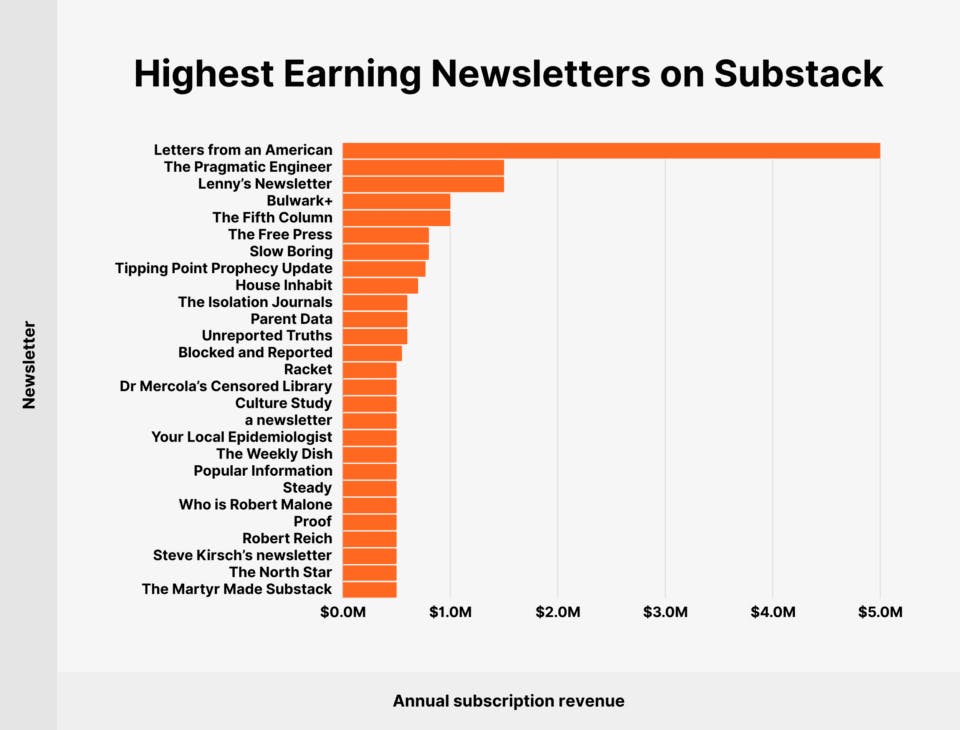
Source: Backlink
Substack's model is built on the belief that people will pay for quality writing and support creators directly, rather than through a media organization. The company has remained averse to advertising, instead focusing on enabling creators to charge their audiences directly. However, as of 2023, Substack has been piloting a program to support certain podcasters by helping them find advertisers, potentially signaling a shift in its stance on advertising.
To expand its global reach and make it easier for international readers to support their favorite publications, Substack announced a suite of product improvements in January 2024. These updates include localized pricing in 13 different currencies, allowing readers to pay for subscriptions using their local currency based on their location.
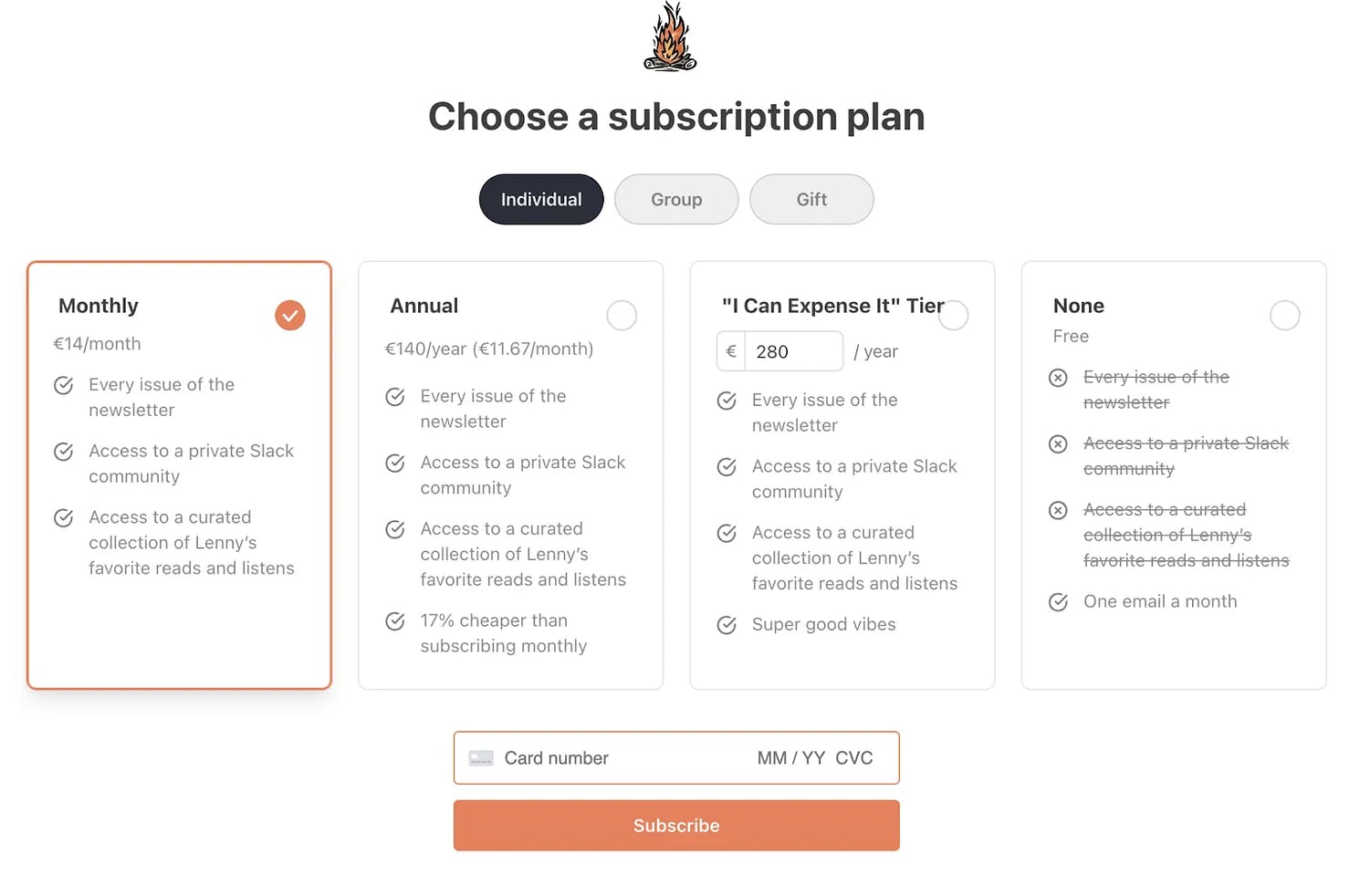
Source: Substack
Traction
In 2021, Substack reported that it had over 1 million paid subscriptions, up from 50K in mid-2019. The company did not disclose the number of free subscribers. Additionally, Substack disclosed that the top 10 writers on the platform make a collective $20 million in annual revenue. In 2022, Substack stated that its network drives more than 40% of all subscriptions across the platform and 12% of paid subscriptions.
In February 2023, Substack reached 2 million paid subscriptions with over 20 million monthly active users and $9 million in revenue at the end of 2021. One unverified estimate indicated that Substack had grown 50% from $19 million in 2022 revenue to $29 million in 2023.
As of February 2024, Substack announced having more than 3 million paid customers. In July 2024, Substack had 85.2 million total visits.
Valuation
As of September 2024, Substack had raised a total of $90.2 million in funding. Substack raised a $65 million Series B round led by Andreessen Horowitz in September 2021. The post-money valuation on its Series B round was $650 million, representing a ~70x multiple on $9 million of revenue at the end of 2021.
In May 2022 as tech company valuations struggled in both public and private markets, Substack announced that it had abandoned its original plans to raise a Series C round.
Shortly after that, in June 2022, Substack announced it was laying off 13 employees, mainly in the human resources and writer support function divisions.
In March 2023, Substack opened up a community fundraising round on Wefunder, in order to let writers themselves own a piece of the company. It started with an initial goal of $2 million and raised $7.8 million from over 6K people.
Key Opportunities
Multimedia Content
As Substack continues to mature, there is an opportunity to expand deeper beyond newsletters into alternative forms of content, such as audio and video. By creating an end-to-end platform that showcases a user's writing, audio, and video work, Substack can reach larger audiences and enable newsletters and blogs to become more engaging. Offering alternative content formats can help freshen up the audience experience and encourage content creators to build more of their brand on Substack, as the platform can host their entire online presence.
In 2024, the company launched a Substack Creator Studio targeted at popular TikTok users, allowing them to export their brand onto the platform. This initiative aims to provide video content creators, who often depend on brand deals and ads that fluctuate with the economy, with a consistent income stream from their audience through Substack's subscription model.
Furthermore, Substack's new integration with Spotify, announced in April 2024, presents an opportunity for the company to expand its reach and offer more value to podcast creators and their fans. Through this partnership, Substack podcast creators can now distribute their free and gated content to Spotify's 602 million monthly active users worldwide, joining a growing list of publishers and platforms offering subscriber-based content powered by Spotify Open Access. This integration enables Substack creators to reach new and existing audiences where they listen most while giving Spotify listeners access to premium content from popular Substack shows like Rich Text, Split Zone Duo, and Culture Study.
Growing Internationally
The company offers local payment methods in 13 currencies and allows subscribers to pay in their local currency without worrying about dollar conversion rates each billing cycle as of January 2024. Although Substack does not support geo-specific pricing for writers as of September 2024, the company has stated that this feature is "very much on [their] radar."
Furthermore, Substack has introduced additional payment methods for subscribers in Europe, such as direct debit and bank portal payments. The company supports European payment methods like iDEAL, Bancontact, Sofort, and SEPA Direct. These new tools and features demonstrate Substack's commitment to better serving its growing international user base.
Network Effects
Substack can enable writers to benefit from network effects and grow its platform further. An early example is the launch of Substack’s recommendations feature, which lets writers recommend other newsletters to their readers. This drives subscriptions to newsletters, incentivizing new writers to join the publishing ecosystem that Substack has built.
Substack can also recommend newsletters to readers based on their subscription history, and this helps drive revenue for writers while improving the user experience. Instead of paying independent subscriptions to newsletters, Substack could let users bundle subscriptions together. For example, instead of paying $20 for two newsletter subscriptions ($10 each), users could pay $15 to access both newsletters if they had a bundle option. This would grow the writer ecosystem further and potentially expand revenue opportunities.
Key Risks
Barriers to Multimedia Expansion
As Substack seeks to grow into a platform that hosts multimedia content like podcasts, it faces an uphill climb to gain traction in a field with dominant incumbents, including podcasting platforms like Apple and Spotify. In June 2024, 35.8% of all podcast listeners used Spotify, while Apple captured 33.8% and Google captured 1.7%. Convincing users with existing listening habits to shift platforms may be difficult, especially as Spotify has a large library of 6 million free podcast titles as of September 2024. Thus, while Substack’s early bet on users willing to pay a premium to access written content from their favorite writers proved to be true, it remains to be seen whether the same thesis will be true for the podcast space.
Consumer Focus
By expanding to other forms of content, Substack could lose popular writers as it tries to strengthen its consumer brand by trying to become another social network or news publisher. The prominent analyst and writer Ben Thompson, whose tech newsletter Stratechery helped inspire Substack, wrote that Substack has gone from being a “faceless publisher” to trying to put “the Substack brand front-and-center.” He added:
“This is a way for Substack to draft off of their popularity to build an alternative revenue model that entails readers paying for Substack first, and publishers second, instead of the other way around.”
Substack’s expansion and desire to grow its brand is evidenced through the launch of its centralized mobile app, attempting to bring the reader into a Substack-controlled experience. But, as noted by Ben Thompson, this could backfire in the long term.
Competing Distribution Outlets
In 2023, after Substack introduced its Notes feature, X (formerly known as Twitter) responded by blocking the circulation of Substack newsletters on its platform. Tweets containing Substack links were hidden in search results and prevented from being liked or retweeted. Although X users can now share Substack links without being blocked as of April 2023, this incident highlights the significant challenges Substack faces in attracting users to its platform.
Prior to this incident, X served as a major social media platform for writers to grow their audiences, with most of Substack's traffic coming from the site in 2022. While creators can still cultivate their audience on platforms other than Substack, the situation with X raises concerns about the potential for rival websites to limit the reach of Substack content. This sets a troubling precedent that could hinder Substack's growth and make it more difficult for the platform to attract and retain creators. As Substack continues to expand its features and compete with other content distribution platforms, it will need to navigate the challenges posed by competing outlets and develop strategies to ensure its content remains accessible and easily shareable across various channels.
Content Moderation
Substack has faced criticism for its hands-off approach to content moderation. In 2020, the company opted for community moderation, allowing publishers to set their own terms of engagement and readers to choose which communities suit them. While this attracts many writers, others have become increasingly frustrated with insufficient content moderation. This has led to controversial cases, such as former New York Times writer Alex Berenson moving to Substack after being banned from Twitter in 2021. Finding the right balance between ensuring content accuracy and limiting top-down moderation is a challenge that other content platforms have also grappled with.
In January 2024, Substack faced a significant controversy when it was revealed that the platform was hosting several Nazi-affiliated newsletters. This situation exposed a fundamental problem with Substack's business model, which relies on a hands-off approach to content moderation. As a result, many high-profile writers threatened to leave the platform, citing concerns about the presence of hate speech and extremist content. Substack initially defended its stance on free speech but announced later that same month that it would remove the offending Nazi publications.
This incident highlights the delicate balance Substack must strike between promoting free speech and maintaining a safe and welcoming environment for all users. As the platform continues to grow, it will need to develop more robust content moderation policies and enforcement mechanisms to prevent similar situations from occurring in the future.
Summary
Substack positions itself as an “economic engine for culture” where writers can grow and retain their own audience. Its initial bet on a subscription-based model instead of relying on ad-based revenue worked and has driven growth on the platform. With 3 million subscribers and 20 million active users, Substack is now better positioned to take the next step and become an economic engine for cultural production. Yet, as Substack seeks to mature, its biggest challenge will be around expanding its revenue sources and product offering while remaining true to its initial mission of making it simple to create a publication that brings in money.


